Virtual Tour: Women's Suffrage in Fort Collins#
Want to explore some of the places where Fort Collins residents helped make women's suffrage a reality? Check out this virtual walking tour of some sites around Old Town related to the 1893 and 1919 movements and the people that made it happen.
Know Before You Go
We encourage you to explore these sites on your own time, by car, bike, or on foot. Please share the street and be respectful to the privacy of the owners and residents of the homes on this tour by viewing them from the street/sidewalk only.
1 - Elizabeth Stone's Cabin, 200 Mathews St., in Library Park#
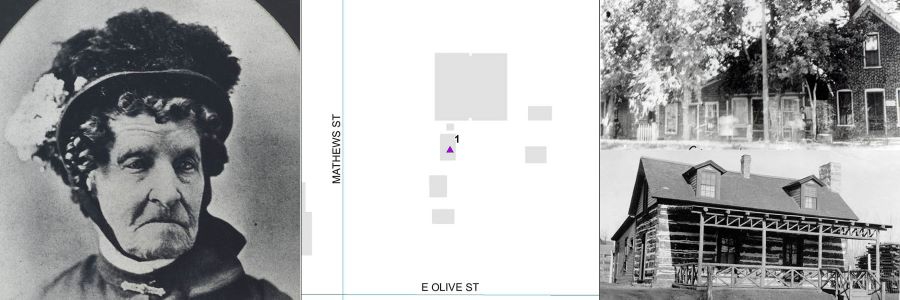
Left: Elizabeth "Auntie" Stone, one of the founders of Fort Collins and an active suffragist, c.1890 (H03002); Top right: Stone's residence at 350 Jefferson Street (photo right) (H14756); Bottom right: Stone Cabin after its first move on Mason Street between Oak and Olive Streets, c.1909 (All images Courtesy of the Fort Collins Museum of Discovery).
Elizabeth Stone is considered a founder of Fort Collins and was a prominent suffragist in the movement leading up to state-wide approval of women’s voting in 1893. She arrived in Fort Collins in 1864 with her husband, Judge Lewis Stone, to run the officers’ mess hall at the short-lived military post. When her husband passed away in 1866, she took over his duties at Fort Collins until the post closed in 1868. She also converted their modest cabin into a public hotel the following year. During the first two decades of the town’s development, Stone co-established the area’s first grist mill, co-founded the region’s first brick yard, and went on to run two of downtown Fort Collins’ hotels, the Metropolitan and the Cottage House. Her old cabin eventually became a schoolhouse, before it was relocated twice, ultimately ending up here at Library Park in an effort to ensure the cabin’s preservation. She lived in a house on the 300 block of Jefferson Street at the location that is now 340-350 Jefferson Street. Stone, among the community’s strongest supporters for suffrage, voted in local school district elections as soon as she was able. In 1894, she voted for the first time in a municipal election at the age of 92. She voted one more time in 1895 before she passed away. This cabin is preserved as a City Landmark.
2 - Lucy McIntyre's Residence, 137-143 Mathews St.#
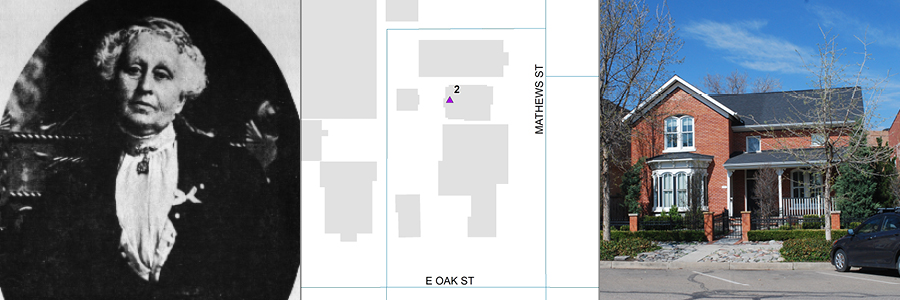
Left: Lucy McIntyre, c.1911 (Courtesy of Fort Collins Museum of Discovery); Right: 137-143 Mathews Street (Fort Collins Historic Preservation Services).
Lucy McIntyre was among the most prominent leaders of Fort Collins’ social organizations and suffrage movement in the late 1800s. Lucy and her husband Josiah arrived in 1878. Lucy was a charter member of the local chapter of the Women’s Christian Temperance Union, a national women’s organization that advocated for both women’s suffrage and prohibition of alcohol. McIntyre also founded the Chautauqua Circle, a small organization she hosted in her parlor for Fort Collins men and women to discuss current issues. McIntyre was originally from Erie County, Pennsylvania and is believed to have been inspired by the Chautauqua movement that began nearby in New York. McIntyre hosted meetings and other suffrage events at her home, wrote articles for local newspapers, and gave speeches throughout the 1880s into the 1910s, not only pressing for statewide suffrage, but supporting national suffrage as well.
Although she was certainly a key leader in the movement, like many White women advocating for suffrage, her words sometimes inclined toward class and race judgments. In an 1893 editorial in the Larimer Independent, McIntyre beings by noting that “it seems strange that in this enlightened age, women should be obliged to ask at the hands of men the right to register their opinions at the ballot box,” and goes on to decry the dangers posed to women of the time from domestic violence and alcoholism. However, in the same article, she invokes xenophobia, noting that American men of the past enfranchised “the scum of the old world” that threatened the very rights of “their” men. She goes on to warn that “it is the ignorant and debauched class which will ‘be voted’ this fall that we have to fear.” Such comments, whether against immigrants, Black Americans, or Hispanic Americans, or all of those groups, were unfortunately common during the later stages of the suffrage movement in the late-1890s and early 1900s. McIntyre’s example stands as a reminder of both the tenacious work of local women to secure the vote, but also the race and class complexities of the movement. McIntyre passed away in 1940. This building has survived but is not currently designated as historic.
3 - First Christian Church at the Mosman Block (remodeled), 252 Linden St.#
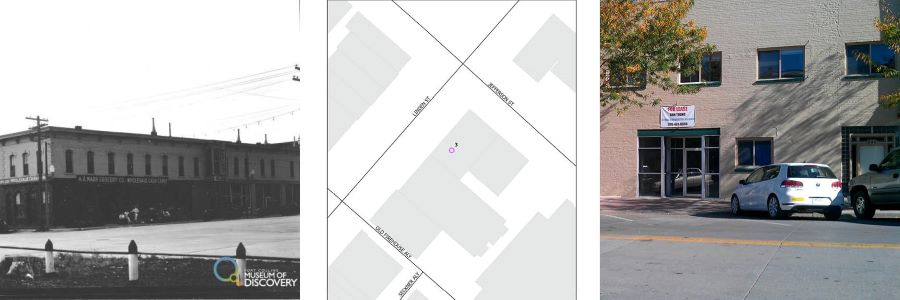
Left: The Mosman Block in 1938 at the southeast corner of Linden & Jefferson, where the First Christian Church met while organizing for the 1893 suffrage campaign. Around 1895, Mossman moved his store to East Mountain where it remained until demolished for a new bank building drive-through in 1962 (H09561a, Courtesy of the Fort Collins Museum of Discovery); Right: The Mosman Block today, after extensive 1950s remodeling.
Churches and schools both served as important organizing and meeting spaces for suffragists throughout the movement. Among the supporting institutions of women’s suffrage was the Christian Church, or First Christian Church as it was later named. In 1893, leading up to the referendum, the Christian Church hosted an Equal Suffrage meeting in September, and regularly hosted pro-suffrage events and speakers. The church did not have its own space, and in 1893, was meeting out of the Mosman Block at 252 Linden Street (the building was modified heavily in the 1950s). Most importantly, the Church hosted both a practice caucus and mock convention for newly minted women voters in early 1894, teaching the basics of how to participate in party politics and the selection of candidates. In 1896, the church constructed its own building at 400 S. College Avenue and continued supporting the suffrage and temperance causes. That church was demolished in 1950 to make way for a new brick sanctuary, which in turn was demolished in 1988 to make way for downtown’s third Safeway building.
4 - Fort Collins City Hall, 232 Walnut Street#
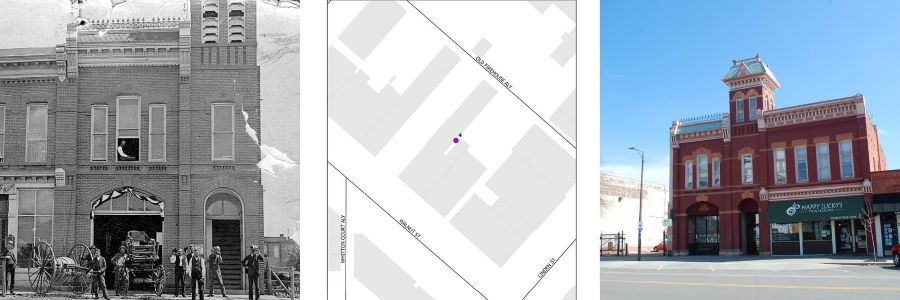
Left: City Hall & Fire Station, c.1882 - Alice Edwards would have served in the city offices on the second floor during her tenure (H00188, Courtesy of the Fort Collins Museum of Discovery); Right: Fort Collins City Hall (1882-1957) (Fort Collins Historic Preservation Services).
What is now Old Firehouse Books was the combined city hall and fire station for most of Fort Collins’ early years. The firehouse itself served as the civic building until the City completed an additional building to the east to expand office space (now Happy Lucky’s Teahouse). Many small communities in the western United States combined all city functions in one building housing only a city clerk for administration and record keeping and a city engineer for street platting and water system development. All other public functions, including firefighting, were usually filled by volunteers. In 1894, women participated for the first time in a Fort Collins election, and Alice Edwards became the first woman elected as an alderwoman for the city (what eventually became City Council). She only served on the town’s council for a year, but in that time participated in several public committees for streets, alleys, bridges, and fire inspection, and helped push through a ban on alcohol sales in city limits – a primary goal for the women’s suffrage movement. It was reported at the time that she was the first woman in Colorado to be elected to municipal office. During her time in office, she would have met with other alderman on the upper floor of the firehouse. It was restored in the early 1980s and is now preserved as part of the Old Town Landmark District.
5 - Ault's Hall and Opera House, 113 & 123 N. College Ave.#
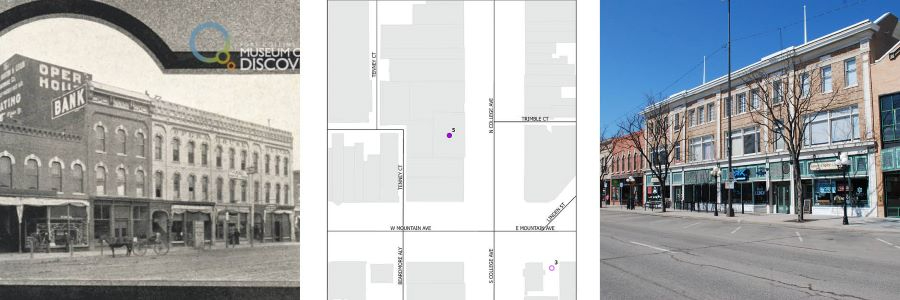
Left: Opera House and Ault's Hall to the left, c.1908 (H21708, Courtesy of the Fort Collins Museum of Discovery); Right: The buildings today (Fort Collins Historic Preservation Services).
These two buildings in downtown Fort Collins were at the heart of the movement for suffrage in Fort Collins. Several meetings and other events of the Women’s Christian Temperance Union took place here between the 1880s and the 1910s. Some of the most pivotal speeches were given in these buildings as well. It was in the Opera House in October 1893 that national suffrage leader Carrie Chapman [Catt] gave a speech in favor of suffrage just prior to the impending statewide referendum on the topic. Chapman, working with Susan B. Anthony and Lucy Stone, was among the most prominent national advocates for women’s suffrage and campaigned in favor of the referendum in Colorado for two months in September and October. On December 13, 1893, local suffragists of Fort Collins held a large celebration of the ballot success with many of the festivities held at the opera house. The Opera House is listed in the National Register of Historic Places but is not a City Landmark.
6 - Patton House & (first) Episcopal church (demolished), College Avenue & Oak Street#
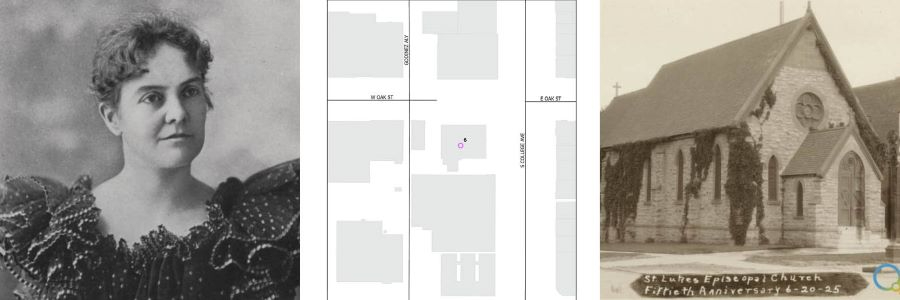
Left: Grace Espy Patton, c.1900; Right: the Episcopal Church formerly at the southeast corner of Oak and College, 1925 (both photos courtesy of the Fort Collins Museum of Discovery).
Grace Espy Patton was raised in Fort Collins, growing up in the family home that used to sit at the southwest corner of College Avenue and Oak Street. Her father purchased the home at 203 S. College Ave. in 1879 and retained it until 1910 when he sold it for use as the new Post Office location. Grace worked as a librarian at the Episcopal Church that used to be across the street from their home (the southeast corner of Oak & College). She enrolled at the Colorado Agricultural College (CAC) when she was 16, and quickly earned a reputation as an outspoken suffragist. During a student exposition in 1883, she celebrated the future of women’s suffrage and the day when “the robes of government are laid over her shoulders.”
Patton graduated in 1885 shortly thereafter she was hired to return to CAC as an instructor, although she was not recognized as a formal member of the faculty (that honor went to Theodosia Ammons, who is covered at the next stop on the tour). Patton taught a host of classes, including chemistry, logic, and stenography. Outside of class, she grew a passion for writing. In 1890, the Denver Times hired her as a reporter. Her success as a journalist aided her at CAC, when the college created a new English and Stenography program with her at the helm.
Alongside her university work, Patton was among the first women in the county to register to vote after the 1893 referendum. In 1894, she became head editor and co-founder of The Tourney, a monthly magazine about literature, politics, and education in the American West. Co-editing with Denver suffragist Mary C.C. Bradford, they renamed the magazine The Colorado Woman by the end of the year. Some of the magazine’s articles in its first year focused on suffrage and its benefits. In 1896, she ran a successful bid to become the State Superintendent of Public Instruction, the second woman in Colorado history to do so. It has been suggested by some scholars that she was the first LGBTQ student and professor at the CAC. While the evidence remains circumstantial, it is possible she maintained a relationship with her colleague Mary Holland Kinkaid, with whom she shared a home in Denver on Pennsylvania Avenue for several years in the 1890s. She did end up marrying a man, Warren Cowles, in 1898, much to the surprise of those who knew her in Fort Collins, as well as her friend, Susan B. Anthony. Unfortunately, she died in 1904 in the Philippines after her and Warren relocated there.
7 - Routt Hall / Domestic Arts Building, 151 W. Laurel at Colorado State University#
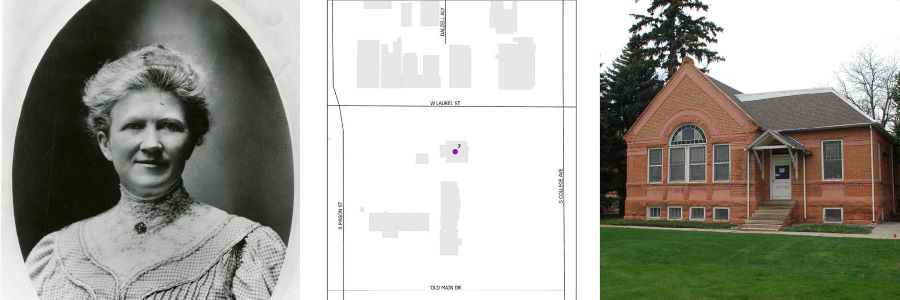
Left: Theodosia Ammons, c.1900 (Courtesy of the Fort Collins Museum of Discovery); Right: Routt Hall, the former Domestic Arts Building, where Dr. Ammons taught (Fort Collins Historic Preservation Services).
Theodosia Ammons was another prominent suffragist in Fort Collins and a leader on women’s issues in the region. While not prominent in the state-wide effort in 1893, she became nationally renowned later in the decade as a suffragist and women’s rights leader. In 1895, in alliance with local activist Elizabeth Tannar and state-wide activist (and the governor’s wife) Eliza Routt, she co-created a Domestic Arts program at Colorado Agricultural College (now Colorado State University) to serve female students. Alongside her many academic and suffrage accomplishments, she was a homesteader, establishing her own property near her family ranch in Douglas County.
Ammons was integral in developing some of the agriculture and domestic arts programs that would become standardized by the cooperative extension service. In 1902, she became the Dean of Woman’s Work at the CAC, becoming the first female dean in the University’s history. Among her first acts was changing the department’s name from the Department of Domestic Economy to the Department of Domestic Science, emphasizing her desire for the department to focus on scientific methods of cooking, hygiene, and home architecture. She taught in this building and gave speeches in favor of suffrage in the chapel at Old Main on campus a few hundred feet to the south (burned down in 1970). As a leader in the regional Chautauqua movement , she designed and built a model home on the grounds of what is now the Colorado Chautauqua, one of the first permanent cottages on those grounds.
She served as the secretary of the Colorado Equal Suffrage Association in the late 1890s and would be elected its president in 1902. That year she represented Colorado at the National Convention of Delegates of Women Suffrage in Washington, D.C., a NAWSA event, noting the successes of women’s suffrage in the state. In her speech there, she argued that women voting would improve American politics, noting it made the nation more equitable. Unfortunately, she passed away in 1907 without seeing the ratification of the Nineteenth Amendment. Routt Hall is listed in the Colorado Register of Historic Properties, but is not protected as a City Landmark.
8 - Elizabeth Tannar Residence, 717 Mathews St.#
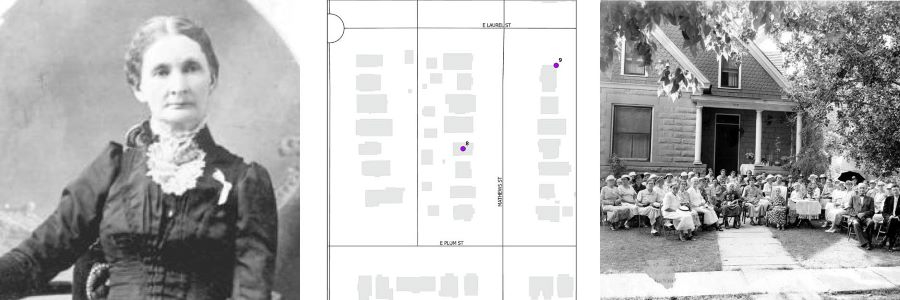
Left: Eliza Tannar, c.1918, and Right: Eliza Tannar’s birthday party at 717 Mathews, c.1936 (both images Courtesy of the Fort Collins Museum of Discovery).
Eliza Tannar (sometimes spelled Tanner) was born in Rochester, Ohio in 1840 to William Marshall and Sophronia Hinckley. She was a student at Oberlin College in Ohio when the Civil War broke out in 1861. Her family story includes helping enslaved people from the south travel north on the Underground Railroad. She married Abram Tannar in 1865 in Rochester, Abram being a veteran of the war. Abram never recovered from his three years of service in the Union Army, dying a few years after they were married. Eliza became a staunch anti-war advocate as a result. Eliza’s son, Hubert, was in poor health and like many Americans at the time, she moved to Colorado for his benefit, believing the dry air and altitude to be of help. Eliza proved up on a homestead in Weld County near Pawnee Buttes (northeast of present-day Keota) in 1887, forming the local school district there and becoming the region’s first teacher. At the same time, she petitioned the state college board to establish a women’s program at the Colorado Agricultural College to teach women about proper homemaking. As noted at the previous stop, such a program was established a few years later with Theodosia Ammons as the head.
Tannar moved to Fort Collins later in 1887. It appears she moved into this house at 717 Mathews that year, renting it from co-owners Katharine C. Ellis and Frank P. Stover, both of whom sold Tannar their interest in the property in 1899 and 1900, respectively. Sadly, her son passed in 1903, but she stayed in Fort Collins for the remainder of her life, advocating for women’s rights and for pacifism. She became a central figure in the local Women’s Christian Temperance Union, as well as humane education (the just treatment of animals and people). She was an ardent pacifist as well, motivated by her late husband’s war experience. Tannar regularly circulated petitions over the 1930s in an effort to discourage Congress from escalating tensions in Europe or with Japan. Eliza died on October 11, 1938 at the age of 98, and donated much of her estate to the American Humane Education Association.
9 - Aylesworth Residence, 704 Mathews St.#
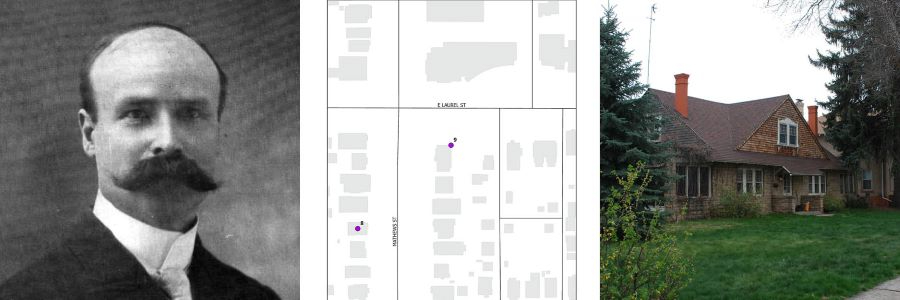
Left: Aylesworth Residence at 704 Mathews St. (Fort Collins Historic Preservation Services); Right: Dr. Barton Aylesworth, c.1906 (Courtesy of the Fort Collins Museum of Discovery).
Men joined the suffrage movement in large numbers leading up to both 1893 and 1920, with the all-male electorate voting for suffrage in Colorado in 1893. This house was the home of Colorado Agricultural College (now CSU) president Barton Aylesworth. Aylesworth was the fourth CAC president from 1899-1909, and had this home constructed in 1903. He and his wife Georgia lived in this house from 1903-1909.
During his tenure, he pressed for balance in the College’s programs between agriculture, civil engineering, mechanical engineering, and domestic arts in equal parts. In the latter course, he proved a strong ally for feminists and suffragists like Theodosia Ammons. During and after Aylesworth’s tenure as CAC President, he promoted women’s suffrage in Colorado and throughout the country. He supported the expansion of women-focused programs at the College at the request of local leaders like Dr. Theodosia Ammons and Eliza Tannar.
After leaving the CAC in 1909, Aylesworth took on a one-year speaking contract for the National American Woman Suffrage Association, traveling the country to advocate for national women’s suffrage. The Coloradoan covered many of his speaking engagements on behalf of suffrage, ranging from Denver to New York to South Dakota. Typical of the late-Victorian period, while he noted the successes of women having the vote, citing examples of improved social welfare and education, he was careful to note that Colorado women did not often seek public office, were focused on successful home-making, and continued to uphold the Victorian-era ideals of the “cult of domesticity,” which considered women as “bastions of virtue,” as educators, and as homemakers, that should be protected from the perceived ugliness of political life. While some women like Grace Espy Patton ignored these gender roles, Americans did not begin to broadly reject domestic gender roles for women until the 1960s and later. In between speaking trips, Aylesworth returned to Fort Collins, although the local family home by that time was at 2500 S. Shields Street. He passed away in Denver in 1933.
The Aylesworth House is listed in the National Register of Historic Places as part of the Laurel School Historic District, but is not individually recognized and is not protected as a City Landmark.
10 - Mrs. Sarah J. Corbin Residence (demolished), 402 Remington St.#
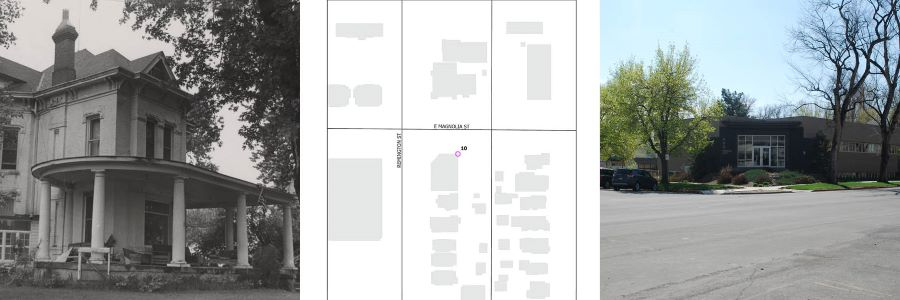
Left: The Sarah Corbin House prior to its demolition to make way for an office building in 1976 (H00905, Courtesy of the Fort Collins Museum of Discovery); Right: the corner where the Corbin House used to stand, as it looks today (Fort Collins Historic Preservation Services).
Sarah Corbin worked alongside Lucy McIntyre as one of Fort Collins’ most prominent suffragists. Sarah (Leffingwell) was born in Pennsylvania in 1835 and married twice, Twiford Corbin being her second spouse, whom she married in 1871.She and Twiford arrived in the city in 1880 and while Twiford established a lumber yard, Sarah soon began advocating for suffrage, including serving in leadership roles in the Women’s Christian Temperance Movement. After the couple had this home built in 1888, Sarah hosted meetings for the WCTU in her parlor, including in the early 1890s, leading up to, and after, the 1893 campaign for state suffrage. She also served as the president of the Corbin and Black Lumber Company for a short period after her husband passed in 1896. Her most significant contribution to suffrage was hosting a four-week course about politics for women at her home in December of 1893, immediately following the successful referendum. The course was intended to help new women voters learn how to caucus and participate in electoral politics now that they had the vote. A class planned for December 22 included study on parliamentary law and political economy. She died in 1903 as a noted advocate for both prohibition and women’s right to vote.